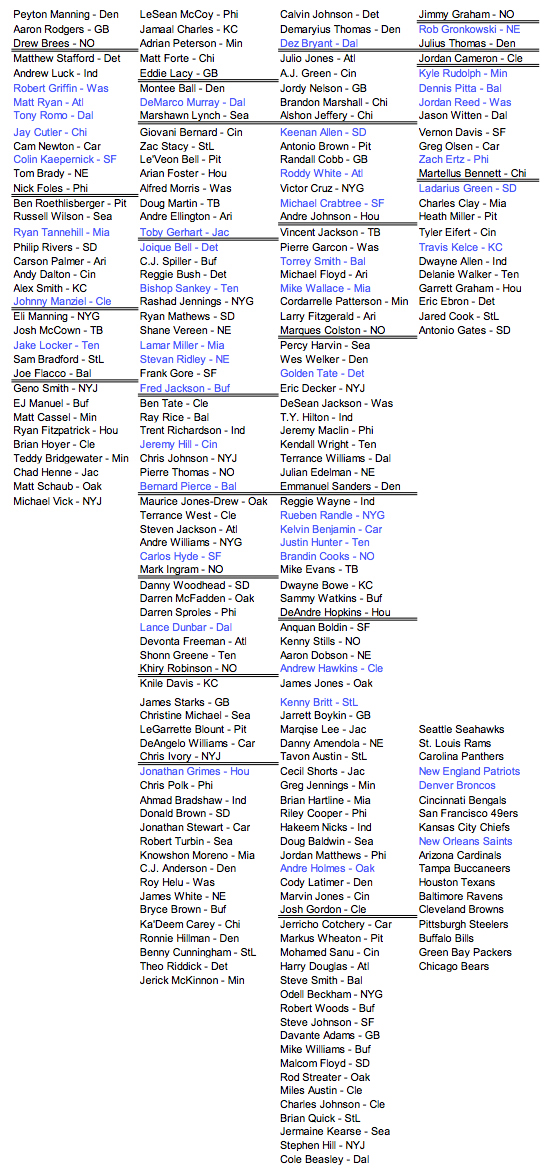Harris: Draft With Tiers To Avoid Tears
By Adam Harris-
(CBS) This is the second of three installments of my draft advice leading up to the fantasy football season, but it's the most important, so let's get right to it.
We refer to this as the "Tier System."
Don't draft strictly based on rankings. After you find an "expert's" rankings you like, organize each position using tiers to make smarter decisions on draft day.
A tier puts ranked quarterbacks, running backs, wide receivers, etc. in separate groupings based on their predicted stats and potential for the fantasy year.
For example, the no-doubt-about-it, top-tier fantasy quarterbacks this year are Denver's Peyton Manning, New Orleans' Drew Brees and Green Bay's Aaron Rodgers.
A quarterback like Detroit's Matthew Stafford is in Tier 2 despite being ranked directly behind the top three named above at fourth overall. His overall ranking can deceive owners because he shouldn't be taken immediately after those three mentioned above, as the drop-off is too big. The tier system will show Stafford ranked right behind the top three fantasy quarterbacks, but at a lower level.
This means you should wait on a quarterback like Stafford after the top three go because there is a group of 10 quarterbacks that fall into Tier 2 who can give you similar seasons.
Coupled with the tier system, you should draft based on value and potential. If you need a receiver but see there's only one running back left available in a high tier, I would suggest drafting the value of the running back even though you might not need a back as much.
For example, if Washington's Alfred Morris is the only back left in Tier 3 and you need a receiver but see that there are plenty of wideouts available in the highest tier left, I would still take Morris, even if I was full at that position.
For those that have trouble following these complex examples, use the great visual below of fantasy football rankings with the tier system built in courtesy of knowledgeable and trustworthy fantasy analyst Andrew Novelli.
The names highlighted in blue are high-upside guys who could have the potential to jump to the next tier midway through the season. Make sure to anticipate significant gaps in tiers that can give you a firm advantage over your opponent each week at that specific position.
Please note that tiers aren't horizontally transferred based on position. The second tier of quarterbacks isn't the same as the second tier of running backs. You need to determine which position means more to you at the time during the draft; still, I stand by my above statement of always taking value and potential over positions.
I use the tier system religiously when drafting because it helps you decide between a few options as the draft progresses. One of the most important things to avoid during a draft is indecision as a pick approaches you.
The tier system gives you the power of decisiveness, more confidence and swagger in the draft. Swagger puts other drafters off their game and gives you another advantage.
Much of a successful draft comes from having a good and level head, and the tier system will do that for you.
A few more quick draft strategies...
--- Know your league's point structure. Some decisions can be made based on whether the league is PPR, half PPR, six-point passing touchdowns, etc. Don't draft based on the bonus point structure for yards because that won't help you enough to reach for a player.
--- Know how many players you play each week at each position. This is an obvious piece of advice but is often overlooked and is perhaps the most important rule. Two-quarterback leagues draft differently than standard lineup leagues.
Thank you to Andrew Novelli for the use of his fantasy rankings in this article. Follow
Andrew on Twitter @NSRScout.
Adam Harris is a producer for 670 The Score. Follow him on Twitter @aharris670 and feel free to ask fantasy questions!




